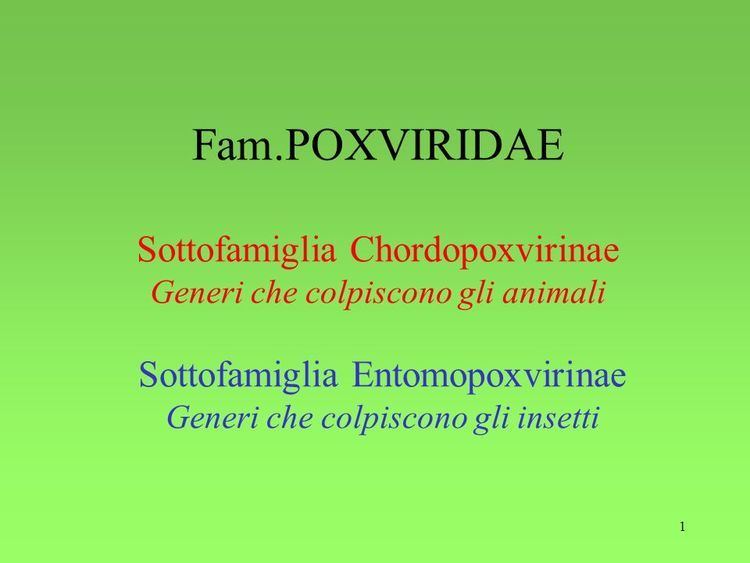Group Group I (dsDNA) Higher classification Poxvirus | Scientific name Chordopoxvirinae Rank Subfamily | |
 | ||
Lower classifications | ||
Medical vocabulary what does chordopoxvirinae mean
Chordopoxvirinae is a subfamily of viruses, in the family Poxviridae. Humans, vertebrates, and arthropods serve as natural hosts. There are currently 38 species in this subfamily, divided among 10 genera. Diseases associated with this subfamily include: Variola virus: smallpox.
Contents
Four genera in this subfamily contain species that infect humans: Molluscipoxvirus, Orthopoxvirus, Parapoxvirus and Yatapoxvirus.
Virology
The virions are generally enveloped though the intracellular mature virion form of the virus, which contains a different envelope, is also infectious. They vary in their shape depending upon the species but are generally shaped like a brick or as an oval form similar to a rounded brick because they are wrapped by the endoplasmic reticulum. The virion is exceptionally large, its size is around 200 nm in diameter and 300 nm in length and carries its genome in a single, linear, double-stranded segment of DNA. Genomes are linear, around 130-375kb in length.
Life Cycle
Viral replication is cytoplasmic. Entry into the host cell is achieved by attachment of the viral proteins to host glycosaminoglycans (GAGs) mediates endocytosis of the virus into the host cell. Fusion with the plasma membrane to release the core into the host cytoplasm. Early phase: early genes are transcribed in the cytoplasm by viral RNA polymerase. Early expression begins at 30 minutes post-infection. Core is completely uncoated as early expression ends, viral genome is now free in the cytoplasm. Intermediate phase: Intermediate genes are expressed, triggering genomic DNA replication at approximately 100 minutes post-infection. Late phase: Late genes are expressed from 140 min to 48 hours post-infection, producing all structural proteins. Assembly of progeny virions starts in cytoplasmic viral factories, producing an spherical immature particle. This virus particle matures into brick-shaped intracellular mature virion (IMV). IMV virion can be released upon cell lysis, or can acquire a second double membrane from trans-Golgi and bud as external enveloped virion (EEV)host receptors, which mediates endocytosis. Replication follows the DNA strand displacement model. DNA-templated transcription is the method of transcription. The virus exits the host cell by microtubular outwards viral transport, and existing in occlusion bodies after cell death and remaining infectious until finding another host. Humans, vertebrates, and arthropods serve as the natural host. Transmission routes are fomite, contact, and air borne particles.
Taxonomy
The classification in this subfamily is based on the morphology, nucleic acid type, mode of replication, host organisms and the type of disease caused.
Nine genera in this subfamily are recognised. There are also a number of species that have not yet been assigned to a genus.
The species in the genus Avipoxvirus infect birds; those in the genera Caiman poxvirus and Crocodylipoxvirus both infect crocidylians.
The other genera in this subfamily infect mammals.
Group: dsDNA
Evolution
The last common ancestor of the extant poxviruses that infect vertebrates existed 0.5 million years ago. The genus Avipoxvirus diverged from the ancestor 249 ± 69 thousand years ago. The ancestor of the genus Orthopoxvirus was next to diverge from the other clades at 0.3 million years ago. A second estimate of this divergence time places this event at 166 ± 43,000 years ago. The division of the Orthopox into the extant species occurred ~14,000 years ago. The genus Leporipoxvirus diverged ~137 ± 35,000 years ago. This was followed by the ancestor of the genus Yatapoxvirus. The last common ancestor of the Capripoxvirus and Suipoxvirus diverged 111 ± 29,000 years ago.
A Bayesian study of Orthopox genomes suggests that the unclassified Yoka poxvirus diverged from the lineage that gave rise to the orthopoxviruses ~90,000 years ago. The orthopox viruses diverged from the other pox viruses about 10,000 yeara ago. Camelpox, taterapox and variola viruses arose 3,500 years ago and horsepox virus ~3,000. These viruses may have arise in these viruses first emerged in the region of the Horn of Africa.
Another Bayesian study suggests that variola arose ~3500 years ago.
